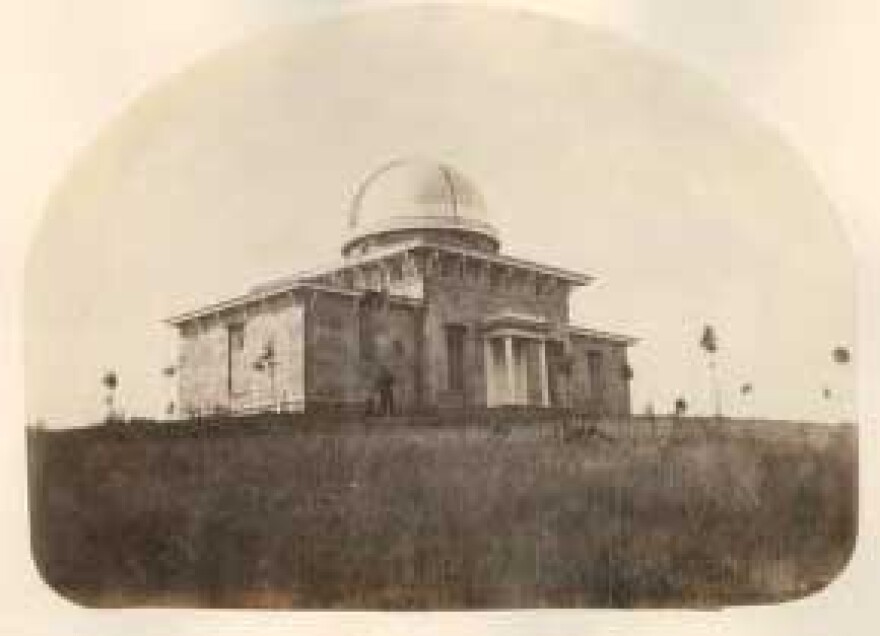Nestled on a hill between dorms on the University of Michigan campus is a beautifully-preserved time capsule.
From the outside, the Detroit Observatory looks almost new, with its crisp white paint and sharp wooden molding. In reality, the observatory dates back over 150 years to the earliest days of University of Michigan’s founding.

History
Historically, the observatory was much more than simply a building to house telescopes.
Karen Wight, Project Coordinator of the Detroit Observatory, explained to Michigan Radio that the observatory represented "the transformation of the University of Michigan from a provincial liberal arts school, into a research institution."
The University of Michigan's first president, Henry Philip Tappan, wanted to create an observatory that integrated a culture of research into the university's identity. According to Rudi Paul Lindner, Professor in the University of Michigan's Department of History, Tappan was successful.
“For the first time, the research was right here," Lindner said. "It was visible. It was on the hill. People lived near by. The researchers themselves were doing the daily teaching, so the contacts between the work of research and the work of undergraduate education was immediately there."
Franz Brunnow, a Prussian astronomer, was hired by Tappan to direct the observatory. He became the first University of Michigan faculty member with a PhD. Under his guidance, a vast body of scientific data was collected and the university's first scholarly journal was published.
In 1973, the Detroit Observatory was listed in the National Register of Historic Places for its significance in science, education, and architecture. Thirty years later, the Bentley Historical Library took on the observatory as "the only three-dimensional archive of university history".
The Bentley Historical Library took on the Detroit Observatory as the only three-dimensional archive of University of Michigan history.
Between 1994-1999, the observatory underwent a massive restoration. The goal was not to renovate or “improve” the observatory, but rather, to restore it to its original condition.
Trains set schedules using a telescope
The telescopes of the Detroit Observatory are perhaps its most defining feature.
When the Fritz telescope was installed in the observatory’s upper floor in 1857, it was the 3rd largest refracting scope in the world, and the largest American-made scope of its kind. It offered astronomers the ability to track and study the stars with unprecedented precision, greatly expanding the university's, and the country's, astronomical knowledge.
On the first floor, a Meridian Circle Telescope was installed. It determined time by tracking stars as they crossed the Meridian.
The time established by this telescope was used to set the time in Detroit and in other cities in the Great Lakes region. The Michigan railroad even used “Detroit Observatory time” to coordinate train transit around the state.

In addition to these two scopes, the observatory contained several “student telescopes” that allowed undergraduates to study the stars without having to compete with research faculty for scope access.
According to the Bentley Historical Library, the observatory is currently "the oldest extant observatory in America to retain its original telescopes from the 1850s in working condition in their original mounts."
Scientific Contributions
Observations and measurements made at the Detroit Observatory did not just pertain to the field of astronomy.
In the observatory’s basement, seismographs were installed that detected earthquakes with epicenters as far away as California, Mexico and Turkestan.
On the main floor, an “automatic barometer” collected barometric pressure, temperature and wind data that was sent to the State Board of Health in Lansing.
The observatory even had a hand in geography, being first site to establish the longitude of Ann Arbor.
The Observatory Today
While modern astronomy research is mostly conducted remotely via computer monitoring, the Detroit Observatory still holds a sentimentality and intrigue for star-enthusiasts.
Every month, visitors are invited to explore the observatory and gaze through the Fritz telescope at planets, stars and more.
- Ari Sandberg, Michigan Radio Newsroom











